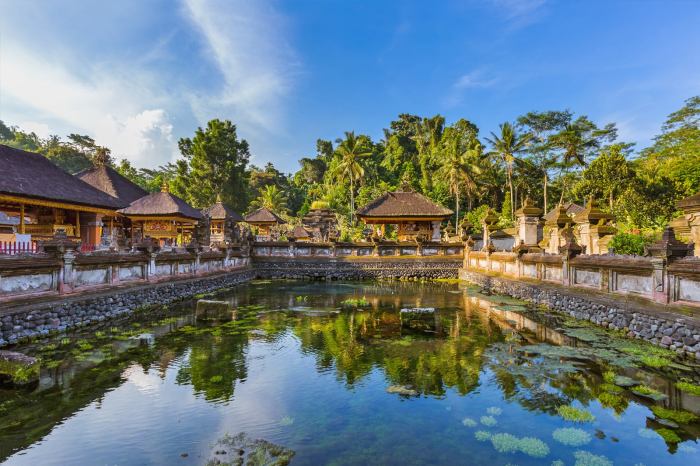Tirta Empul, an ancient and sacred spring in Bali, Indonesia, has captivated pilgrims and tourists alike for centuries. Its crystal-clear waters are believed to possess healing and purifying properties, making it a significant pilgrimage site for Balinese Hindus and a must-visit destination for travelers seeking spiritual enlightenment and cultural immersion.
Built in the 10th century, Tirta Empul’s architectural design and layout are as impressive as its spiritual significance. The complex features a series of bathing pools, fountains, and temples, each adorned with intricate carvings and sculptures that depict scenes from Hindu mythology.
Historical Significance: Tirta Empul
Tirta Empul holds immense historical significance, dating back to the 10th century during the reign of the Warmadewa dynasty in Bali. According to Balinese legend, the site was created by the god Indra, who struck the ground with his thunderbolt, releasing holy water from the earth.
The name “Tirta Empul” translates to “Holy Spring of the Temple,” reflecting its sacred nature.
Tirta Empul is a famous temple in Bali, Indonesia, known for its holy spring water. While exploring Southeast Asia, you may also want to consider visiting Phuket , a beautiful island in Thailand with stunning beaches and a vibrant culture.
However, when you return to Tirta Empul, don’t forget to immerse yourself in the sacred waters and seek purification and spiritual renewal.
Construction and Cultural Impact
The temple complex was constructed in the Balinese architectural style, featuring intricate carvings, stone sculptures, and multiple bathing pools. Over the centuries, Tirta Empul has become a vital cultural and religious center for Balinese Hindus. It serves as a place of pilgrimage, purification, and spiritual renewal.
Ancient Rituals and Ceremonies
Tirta Empul is renowned for its ancient rituals and ceremonies. The most prominent is the “Melukat” ceremony, a purification ritual where devotees bathe in the holy spring water to cleanse themselves of sins and negative energies. The water is believed to have healing properties and is said to bring blessings and good fortune.
Tirta Empul is a water temple in Bali that’s known for its sacred springs. It’s a popular destination for both locals and tourists alike. If you’re looking for a place to stay near Tirta Empul, RedDoorz Semarang is a great option.
It’s located just a short drive from the temple and offers affordable rates. Plus, the staff is friendly and helpful, and the rooms are clean and comfortable. After a day of exploring Tirta Empul, you can relax and unwind at RedDoorz Semarang.
Architectural Features

Tirta Empul exhibits an intricate architectural design with symbolic elements and sacred spaces. The complex consists of a series of bathing pools, fountains, and temples arranged along a central axis.
Bathing Pools
The bathing pools are the focal point of the complex. There are three main pools, each dedicated to a different purpose:
- Pancuran Suci:The holy spring where pilgrims bathe to cleanse themselves.
- Pancuran Pabersihan:The purification pool where people wash their bodies before entering the holy spring.
- Pancuran Pengelukatan:The pool of renewal, used for ritual purification ceremonies.
Fountains
The fountains, known as pancuran, are strategically placed around the pools. Each fountain represents a different deity and is believed to possess healing properties. Pilgrims bathe under the fountains to receive blessings and purify themselves.
Temples
The complex includes several temples, including:
- Pura Penataran:The main temple dedicated to the water goddess Dewi Danu.
- Pura Dalem:The inner temple, where offerings are made to the spirits of the ancestors.
- Pura Tirta Pangentas:A small temple dedicated to the goddess of fertility.
Symbolism and Iconography
Tirta Empul is adorned with intricate carvings, sculptures, and reliefs that depict mythological scenes and symbols. These include:
- Water:The pools and fountains symbolize the life-giving properties of water and its purifying nature.
- Lotus:The lotus flower, a symbol of purity and enlightenment, is frequently depicted throughout the complex.
- Makara:Mythical sea creatures, makara are often carved into the fountains and symbolize the power of water.
Water Properties and Healing Beliefs

The water at Tirta Empul is believed to possess unique properties that contribute to its healing and purifying powers. The water is naturally spring-fed and is said to contain a high concentration of minerals, including calcium, magnesium, and potassium.
According to traditional beliefs, the water has the ability to cleanse the body of impurities and restore balance and harmony. It is said to be particularly effective in treating skin conditions, digestive problems, and respiratory ailments.
Anecdotes and Stories
There are numerous anecdotes and stories about the healing benefits of the water at Tirta Empul. One common story tells of a young woman who suffered from a severe skin condition. After bathing in the water, her skin condition reportedly cleared up completely.
Another story tells of a man who was suffering from a respiratory ailment. After drinking the water, his symptoms reportedly improved significantly.
Tirta Empul, the sacred spring temple in Bali, Indonesia, is renowned for its purifying waters. Similar to the serene Laos pools , Tirta Empul invites visitors to immerse themselves in its spiritual ambiance. With its intricate carvings and cascading pools, Tirta Empul offers a glimpse into the rich cultural heritage of the region.
Cultural Practices and Rituals
Tirta Empul is a site of immense cultural and spiritual significance, where various rituals and practices are performed. These rituals hold deep meaning and play a crucial role in the lives of Balinese Hindus.
Purification Rituals, Tirta empul
At the heart of Tirta Empul’s cultural practices are purification rituals. Devotees bathe in the sacred springs, seeking to cleanse themselves of impurities and negative energies. The water is believed to possess healing and purifying properties, washing away sins and bringing spiritual renewal.
Offerings and Prayers
Offerings of flowers, incense, and other items are made to the gods and spirits at the temple. These offerings symbolize gratitude, respect, and a desire for blessings. Devotees also engage in prayers and meditation, connecting with the divine and seeking guidance and protection.
Role of Priests and Spiritual Leaders
Priests and spiritual leaders play a vital role in the rituals and ceremonies at Tirta Empul. They guide devotees through the purification process, offer blessings, and perform special prayers. Their knowledge and wisdom help ensure the rituals are conducted correctly and with the utmost respect for tradition.
Tourism and Preservation

Tirta Empul holds immense significance as a tourist destination, attracting numerous visitors annually. Its historical and cultural significance, coupled with its serene atmosphere and natural beauty, make it a popular pilgrimage site and a sought-after destination for tourists seeking cultural immersion and spiritual enlightenment.Preservation efforts at Tirta Empul have been ongoing, with initiatives focused on maintaining the site’s authenticity and protecting its cultural and environmental integrity.
The Balinese government and local communities play a crucial role in these efforts, implementing regulations and guidelines to ensure the preservation of the temple’s sacredness and its natural surroundings.
Visitor Facilities
To enhance the visitor experience, Tirta Empul offers various facilities, including:
- Ample parking spaces for cars and tour buses
- Guided tours led by knowledgeable local guides
- Rest areas and shaded pavilions for visitors to relax and take in the surroundings
- Souvenir shops selling traditional Balinese crafts and religious artifacts
- Food and beverage outlets offering local delicacies and refreshments
Accessibility
Tirta Empul is easily accessible by road, with well-maintained roads leading to the temple. Visitors can opt for self-driving, hiring a taxi or private driver, or joining organized tours that include transportation to the site.
Guidelines
To maintain the sanctity and cultural significance of Tirta Empul, visitors are expected to adhere to certain guidelines:
- Dress respectfully, covering shoulders and knees. Sarongs or traditional Balinese attire can be rented at the site.
- Be mindful of noise levels and refrain from engaging in loud conversations or disruptive behavior.
- Respect the sacred nature of the temple and refrain from touching or climbing on religious structures.
- Photography is permitted, but visitors are requested to be respectful of others and avoid using flash photography.
Conclusion

Tirta Empul continues to be a place of profound spiritual importance for Balinese Hindus and a captivating destination for travelers worldwide. Its unique blend of history, architecture, and spiritual beliefs make it a truly unforgettable experience.
Question & Answer Hub
What is the historical significance of Tirta Empul?
Tirta Empul was built in the 10th century by King Indrajaya and has been a significant pilgrimage site for Balinese Hindus ever since. It is believed that the spring’s waters have healing and purifying properties.
What are the architectural features of Tirta Empul?
The complex features a series of bathing pools, fountains, and temples, each adorned with intricate carvings and sculptures that depict scenes from Hindu mythology.
What are the cultural practices and rituals performed at Tirta Empul?
Pilgrims come to Tirta Empul to perform purification rituals, make offerings, and pray. The priests and spiritual leaders of the temple play an important role in these practices.